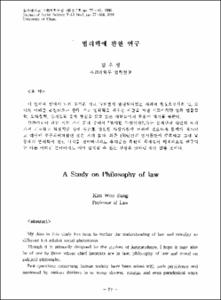염소 저장탱크의 가스누출 예측 및 제어를 위한 스크리닝 방법론
- Alternative Title
- Screening Methodology for Prediction and Control of Gas Releases from the Chlorine Storage Tank
- Abstract
- 본 연구는 화학장치설비 중 염소 저장탱크의 누출유형에 따른 누출물의 물성자료들을 포함하는 누출원모델, 분산모델, 기상 및 지형자료들을 TSCREEN 모델에 입력시켜 염소 가스의 풍하거리에 따른 1시간 평균 최대 지표면 농도를 산출함으로써 유해독성가스의 누출 예측 및 제어를 위한 스크리닝 방법론을 개발하기 위한 것이다. 본 스크리닝 방법론에서는 저장탱크 및 압력방출장치로부터 누출되는 기상 및 2상 흐름의 연속 및 순간 누출에 대한 대기분산 모델링 절차가 고려되었다.
연구결과로부터, 공기보다 무거운 가스의 분산유형은 누출물의 상태(기상 및 2상 흐름), 누출 조건(온도, 압력), 누출물의 물리·화학적 특성, 누출유형(연속 및 순간누출)에 영향을 받고 있으며, 특히 누출물의 초기(감압) 밀도 및 누출속도 뿐만 아니라 풍속 및 대기안정도에 커다란 영향을 받고 있음을 알 수 있었다. 결론적으로, 지표면 농도는 풍속이 낮을수록 대기안정도가 안정할수록 증가하고 있음을 알 수 있었다.
본 스크리닝 방법론은 보다 다종다양한 시나리오들을 선정하여 보편적?막? 적용할 수 있는 Sliding Scale 방법론을 개발함으로써 정교한 해석 모델의 적용시 예비 가이드라인으로 활용될 수 있으리라 사료된다.
This study was performed to develop the screening methodology for prediction and control of hazardous/toxic gas releases by estimating the 1-hr average maximum ground-level concentration of Cl₂gas vs. downwind distance by incorporating source term model including the general/physical properties of released material and release mode of the Cl₂storage tank of the chemical plant facilities, dispersion model, and meteorological/topographical data into the TSCREEN model. For this screening modeling, dispersion modeling procedures for continuous and instantaneous releases of the gas phase and two-phase flow from the storage tank and pressure relief valve were considered.
As the results of the study, it was found that dispersion modes of the dense gas were affected by the state of the released material(gas phase, two-phase flow), the released conditions(temperature, pressure), physical-chemical properties of released material, and the the released modes(continuous and instantaneous releases), and especially largely affected by initial(depressurized) density of the released material and release emission rate as well as the wind velocity and the atmospheirc stability. Consequently, it was found that the maximum ground-level concentration increases as the wind speed is low and the atmospheric stability is stable.
This study was performed to develop the screening methodology for prediction and control of hazardous/toxic gas releases by estimating the 1-hr average maximum ground-level concentration of Cl₂gas vs. downwind distance by incorporating source term model including the general/physical properties of released material and release mode of the Cl₂storage tank of the chemical plant facilities, dispersion model, and meteorological/topographical data into the TSCREEN model. For this screening modeling, dispersion modeling procedures for continuous and instantaneous releases of the gas phase and two-phase flow from the storage tank and pressure relief valve were considered.
As the results of the study, it was found that dispersion modes of the dense gas were affected by the state of the released material(gas phase, two-phase flow), the released conditions(temperature, pressure), physical-chemical properties of released material, and the the released modes(continuous and instantaneous releases), and especially largely affected by initial(depressurized) density of the released material and release emission rate as well as the wind velocity and the atmospheirc stability. Consequently, it was found that the maximum ground-level concentration increases as the wind speed is low and the atmospheric stability is stable.
- Issued Date
- 1998
- Type
- Research Laboratory
- Alternative Author(s)
- Song, Duk-Man; Park, Jong-Kyu
- Publisher
- 공학연구논문집
- Language
- kor
- Rights
- 울산대학교 저작물은 저작권에 의해 보호받습니다.
- Citation Volume
- 29
- Citation Number
- 2
- Citation Start Page
- 39
- Citation End Page
- 57
- Appears in Collections:
- Research Laboratory > Engineering Research
- 파일 목록
-
-
Download
 000002024183.pdf
기타 데이터 / 1.27 MB / Adobe PDF
000002024183.pdf
기타 데이터 / 1.27 MB / Adobe PDF
-
Items in Repository are protected by copyright, with all rights reserved, unless otherwise indicated.